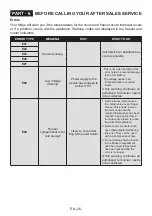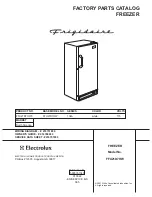
EN -22-
• The taste of some spices found in cooked dishes (anise, basilica, watercress, vinegar,
assorted spices, ginger, garlic, onion, mustard, thyme, marjoram, black pepper, etc.)
changes and they assume a strong taste when they are stored for a long period of time.
Therefore, add small amounts of spices to food to be frozen, or the desired spice should
be added after the food has thawed.
• The storage time of food is dependent on the type of oil used. Suitable oils are margarine,
calf fat, olive oil and butter. Unsuitable oils are peanut oil and pig fat.
• Food in liquid form should be frozen in plastic cups and other food should be frozen in
plastic folios or bags.
The table below is a quick guide to show you the most efficient way to store the major
food groups in your freezer compartment.
Meat and fish
Preparation
Maximum storage time
(months)
Steak
Wrap in foil
6 - 8
Lamb meat
Wrap in foil
6 - 8
Veal roast
Wrap in foil
6 - 8
Veal cubes
In small pieces
6 - 8
Lamb cubes
In pieces
4 - 8
Minced meat
In packaging without using spices
1 - 3
Giblets (pieces)
In pieces
1 - 3
Bologna sausage/
salami
Should be kept packaged even if it has a
membrane
Chicken and turkey
Wrap in foil
4 - 6
Goose and duck
Wrap in foil
4 - 6
Deer, rabbit, wild
boar
In 2.5 kg portions or as fillets
6 - 8
Freshwater fish
(Salmon, Carp,
Crane, Catfish)
After cleaning the bowels and scales of the
fish, wash and dry it. If necessary, remove the
tail and head.
2
Lean fish (Bass,
Turbot, Flounder)
4
Fatty fishes (Tuna,
Mackerel, Bluefish,
Anchovy)
2 - 4
Shellfish
Clean and in a bag
4 - 6
Caviar
In its packaging, or in an aluminium or plastic
container
2 - 3
Snails
In salty water, or in an aluminium or plastic
container
3
NOTE:
Thawed frozen meat should be cooked as fresh meat. If the meat is not cooked after
defrosting, it must not be re-frozen.











































